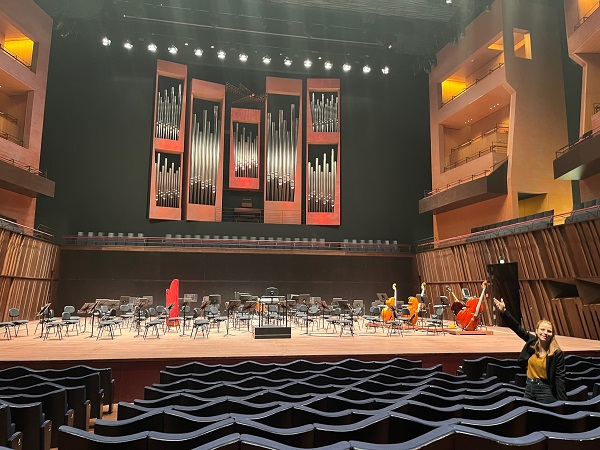
On Saturday 30 April 2022, the Irish Club of Luxembourg had their second face-to-face event of the year; after the St Patrick's Meal in mid-March, the club has organised another guided tour (following on from such events to Bernard-Massard (wine & crémant), Bofferding (beer & water), Ramborn (cider & juices) and the Mine Tour in Rumelange), this time to the Philharmonie in Luxembourg-Kirchberg.
With around 25 members and friends participating, tour guide Laura explained that the vision for the national concert hall started in 1996 when the Place de l'Europe was being designed and built. A cultural focal point was missing, so an elliptical structure was built, linking the Boulevard JF Kennedy in Kirchberg to the cathedral in the city of Luxembourg.
The guided tour focussed on the architecture and the meanings behind the design, with the sun streaming into the building through the steel columns (which number 823 in total) which represent trees - upon entering, you feel you are being transported into a magical forest. She explained that around 450-500 concerts are performed annually, with conferences also being held in the various rooms and spaces available.
The Chamber Music Room has around 300 seats; she explained the design of the acoustics, and the various acoustic reflectors, with the materials (of the ceiling, walls, stage floor and seating) all being taken into account in the design to ensure the best audio quality. She also explained the system for ensuring maintaining equilibrium in temperature and humidity, the two things in which musical instruments hate changes.
Back into the main foyer and up the raised walkway to the "Foyer de Ciel" which offers truly magnificent views of the city; here she explained the complex lighting system that communicates with the outside that informs them that concerts are happening, and welcoming and inviting people inside.
Around 80 people work in the various offices inside in the Philharmonie, from booking to marketing and technicians.
Inside the Grand Auditorium, she explained that the centrepiece can seat 1,500 people at any one time. Here also she explained the acoustic design and the different acoustic reflector panel settings (also using the wooden "towers" and ceiling "waves"): for when an orchestra is performing, when modern / jazz music is being played, and other music. She also explained that when orchestras are playing, they do so without using microphones as no sound amplification is needed, unlike in concerts featuring more modern music. She also explained that the "reverberation time is 1.2 - 2.0 seconds, which is very, very fast for an untrained ear: This allows audiences to sing along in unison, unlike in open air venues / sports stadia, for example.
The Philharmonie opened in 2005 (next time you are there, look closely at the wooden surrounds of the 6,800(!) organ pipes to see this date-stamp. The stage can be configured in various combinations, including having an orchestra pit and also to make space for a 200-member choir.
Next on the tour itinerary were "backstage", in the wings and the artists changing rooms. Last up was a large photo gallery of famous artists who had performed there, from Sir Simon Rattle (conductor) to Nigel Kennedy (violinist) and Woody Allen (clarinet).
Following the tour, which lasted almost 90 minutes (Laura answered a lot of questions!), over half of the group went across the Bld JF Kennedy to the restaurant in the Mama Shelter Luxembourg hotel for a delicious lunch and lengthy discussion, only breaking up at around 15:30. The question was asked: when is the next Guided Tour the club is organising?, showing its popularity from members and friends (not only Irish, but also Polish, Luxembourgish, American, Maltese and French).









